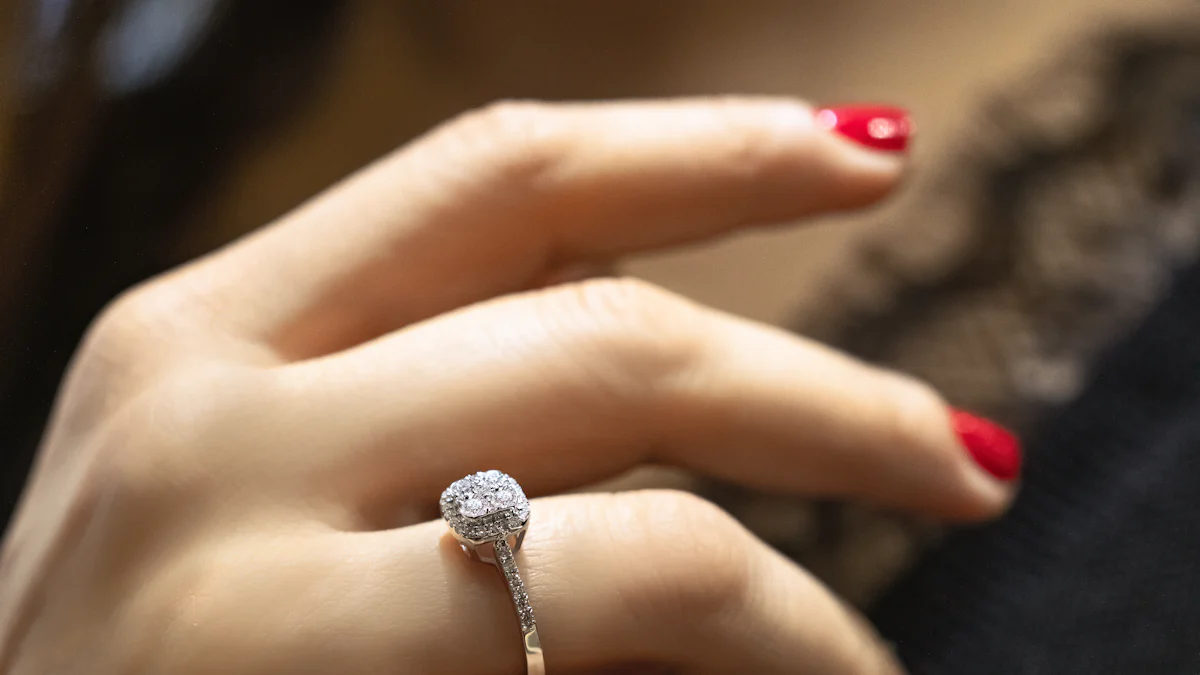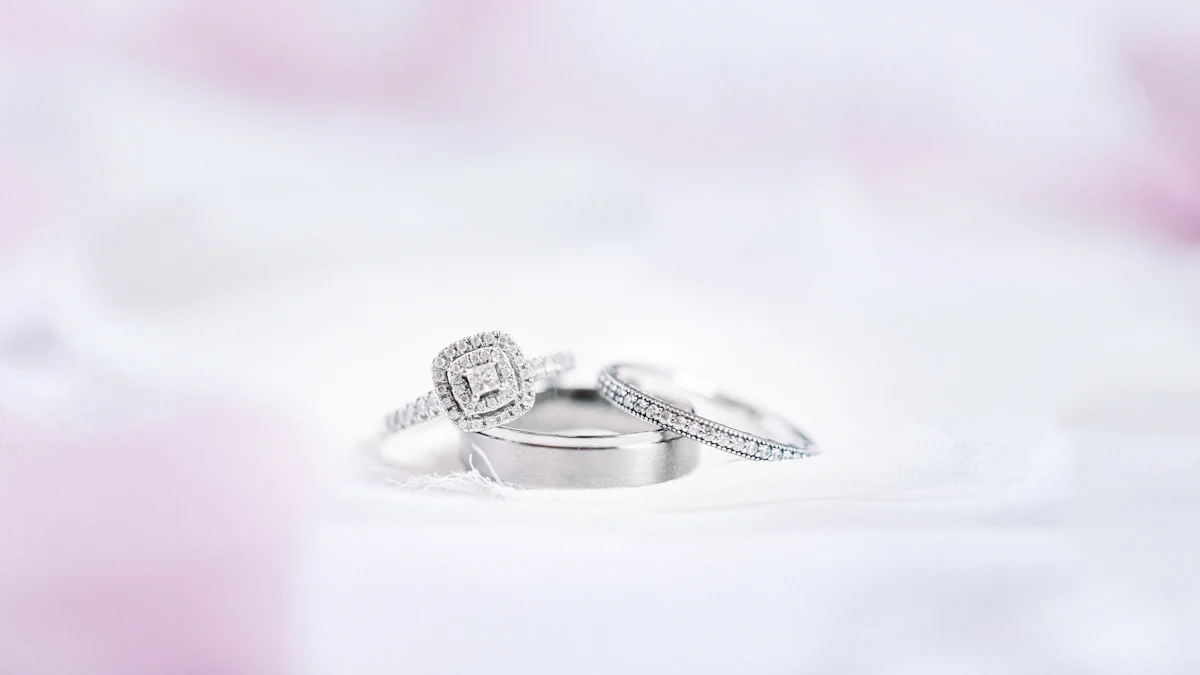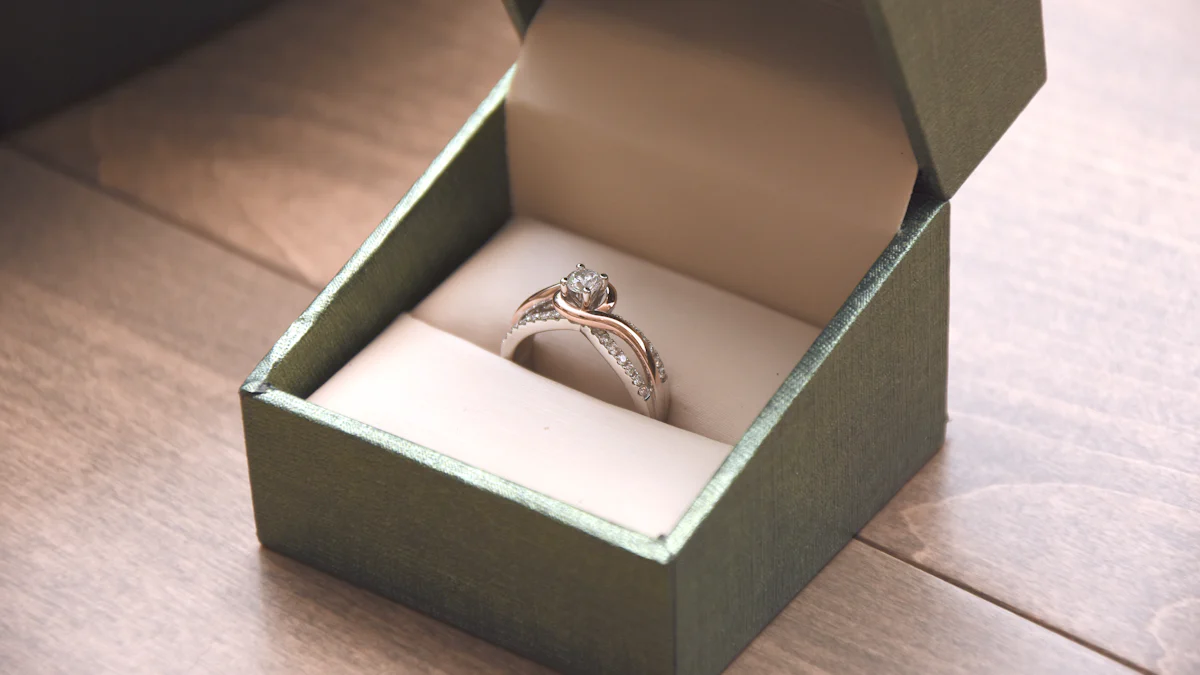Tips for Buying a One Carat Solitaire Diamond Ring

Purchasing a one carat solitaire diamond ring marks a significant milestone in many people's lives. This classic choice symbolizes elegance and commitment, making it a popular option for engagement rings. You might find the one carat size appealing due to its perfect balance between size and affordability. With prices ranging from $1,000 to $3,000, it fits various budgets. Understanding key factors like the diamond's cut, color, clarity, and carat weight ensures you make an informed decision. These elements greatly influence the diamond's beauty and value, helping you choose a ring that truly resonates with your personal style.
Key Takeaways
- Understand the 4Cs—Cut, Color, Clarity, and Carat Weight—as they are crucial in determining the quality and value of your diamond.
- Aim for a diamond with an 'Excellent' or 'Very Good' cut to maximize its sparkle and brilliance.
- Choose a color grade in the D-G range for a beautiful, white appearance without breaking the bank.
- Select a clarity grade of VS1 or VS2 to ensure your diamond looks flawless to the naked eye.
- Consider the setting and metal choice carefully, as they significantly impact the ring's overall style and durability.
- Decide between online and in-store shopping based on your preferences for convenience or hands-on experience.
- Set a budget before shopping to help you find a diamond that meets your expectations without overspending.
Understanding the 4Cs of One Carat Solitaire Diamonds

When you're on the hunt for the perfect one carat solitaire diamond, understanding the 4Cs—Cut, Color, Clarity, and Carat Weight—is essential. These factors determine the diamond's quality, beauty, and value. Let's dive into each one to help you make an informed choice.
Cut
The cut of a diamond is all about how well it reflects light, creating that stunning sparkle everyone loves. A well-cut diamond will dazzle with brilliance, while a poorly cut one might look dull. You should aim for a cut grade of "Excellent" or "Very Good." This ensures your diamond captures and reflects light beautifully. Remember, the cut is not about the shape but the quality of the angles and facets. A well-cut one carat solitaire diamond will stand out and make a lasting impression.
Color
Diamonds come in a range of colors, graded from D (colorless) to Z (light color). Colorless diamonds are rare and highly sought after, but they can be pricey. For a balance of beauty and value, consider diamonds in the D-G range. These diamonds appear white and are more affordable than the top-tier colorless ones. When choosing a one carat solitaire diamond, ensure it looks white to the naked eye, as this enhances its overall appeal.
Clarity
Clarity refers to the presence of imperfections, known as inclusions, within the diamond. These can affect the diamond's appearance and value. For a one carat solitaire diamond, a clarity grade of VS1 or VS2 usually means it will look flawless to the naked eye. Larger diamonds, like a one carat, can show inclusions more easily, so it's crucial to choose wisely. Avoid lower clarity grades such as SI2 or I1, as these may have visible imperfections that detract from the diamond's beauty.
Understanding these 4Cs will guide you in selecting a one carat solitaire diamond that not only fits your budget but also matches your personal style. Each C plays a vital role in determining the diamond's overall quality and value, ensuring you find a piece that truly resonates with you.
Carat Weight
When it comes to diamonds, the term "carat" refers to the weight of the stone. A one carat solitaire diamond is a popular choice for many because it strikes a perfect balance between size and sparkle. You might wonder why carat weight matters so much. Well, it directly influences the diamond's size and, consequently, its price.
-
Understanding Carat Weight:
- One carat equals 200 milligrams. This measurement might seem small, but in the world of diamonds, it makes a big difference. The carat weight affects not only the size but also the perceived value of the diamond. A one carat diamond is often seen as a standard size for engagement rings, offering a noticeable presence without being overwhelming.
-
Carat Weight vs. Size:
- It's important to note that carat weight doesn't always equate to size. Two diamonds of the same carat weight can appear different in size depending on their cut. A well-cut diamond will maximize its carat weight, making it look larger than a poorly cut one. So, when you're choosing a one carat solitaire diamond, consider how the cut complements the carat weight.
-
Budget Considerations:
- Carat weight significantly impacts the price of a diamond. As the carat weight increases, so does the price, often exponentially. Setting a budget before you start shopping can help you find a diamond that meets your size expectations without breaking the bank. Remember, a slightly smaller diamond with an excellent cut can often appear more brilliant than a larger one with a mediocre cut.
-
- Ultimately, the right carat weight for you depends on personal preference. Some people prefer the classic look of a one carat solitaire diamond, while others might opt for something larger or smaller. Consider what feels right for you and what fits your lifestyle.
Understanding carat weight helps you make an informed decision when selecting a diamond. It ensures that you get the best value for your investment, aligning with your personal style and budget.
Practical Tips for Selecting the Right One Carat Solitaire Diamond
Choosing the perfect one carat solitaire diamond involves more than just understanding the 4Cs. You also need to consider the setting, metal choice, and your personal style. Let's explore these aspects to help you make a well-rounded decision.
Choosing the Setting
The setting of your diamond ring plays a crucial role in its overall appearance. It not only secures the diamond but also enhances its beauty. Here are some popular settings to consider:
-
Prong Setting: This classic choice uses metal prongs to hold the diamond in place. It allows maximum light to enter the diamond, enhancing its sparkle. A prong setting is ideal if you want your one carat solitaire diamond to shine brightly.
-
Bezel Setting: This setting surrounds the diamond with a thin metal rim. It offers excellent protection, making it a great option for those with an active lifestyle. While it may slightly reduce the diamond's brilliance, it provides a sleek and modern look.
-
Halo Setting: This setting features a circle of smaller diamonds around the center stone. It can make your one carat diamond appear larger and more dazzling. If you love extra sparkle, the halo setting might be the perfect choice for you.
Metal Choice
The metal you choose for your ring band can significantly impact its style and durability. Here are some common options:
-
Platinum: Known for its strength and hypoallergenic properties, platinum is a popular choice for engagement rings. It has a natural white sheen that complements the brilliance of a one carat solitaire diamond.
-
White Gold: This metal offers a similar look to platinum but at a lower cost. It's a versatile choice that pairs well with any diamond color.
-
Yellow Gold: A timeless option, yellow gold adds warmth and richness to your ring. It creates a beautiful contrast with a colorless diamond.
-
Rose Gold: This trendy metal has a romantic pink hue. It adds a unique and modern touch to your ring, making it stand out.
Personal Style and Preferences
Your personal style should guide your choice of a one carat solitaire diamond ring. Consider how the ring will fit into your daily life and wardrobe. Do you prefer a classic and timeless look, or are you drawn to modern and unique designs? Think about your lifestyle as well. If you lead an active life, you might want a setting that offers more protection for your diamond.
Ultimately, your ring should reflect who you are. Take your time to explore different styles and settings. Try on various options to see what feels right. Remember, this ring is a symbol of your love and commitment, so it should resonate with you on a personal level.
Shopping for One Carat Solitaire Diamonds: Online vs. In-Store

When you're ready to buy a one carat solitaire diamond, you might wonder whether to shop online or visit a store. Both options have their perks, and understanding them can help you make the best choice.
Benefits of Online Shopping
Shopping online for a diamond ring offers several advantages. First, you get access to a vast selection of diamonds from various retailers. This means you can compare prices and find the best deal without leaving your home. Online stores often provide detailed information about each diamond, including the 4Cs, which helps you make an informed decision.
Another benefit is convenience. You can browse and purchase at any time, day or night. This flexibility is perfect if you have a busy schedule. Plus, many online retailers offer competitive pricing because they don't have the overhead costs of physical stores. You might find a high-quality diamond at a lower price online.
Online shopping also allows you to read customer reviews and ratings. These insights can guide you in choosing a reputable retailer and a diamond that meets your expectations. Some online stores even offer virtual try-on features, so you can see how the ring looks on your hand.
Advantages of In-Store Shopping
Visiting a physical store provides a different experience. You can see and touch the diamonds, which helps you assess their quality firsthand. This tactile experience can be reassuring, especially if you're new to buying diamonds.
In-store shopping also gives you the chance to speak with knowledgeable staff. They can answer your questions, offer advice, and guide you through the selection process. This personalized service can be invaluable, particularly if you're unsure about the 4Cs or other aspects of diamond buying.
Additionally, trying on rings in person allows you to see how different settings and metals look on your hand. You can experiment with various styles to find the one that suits you best. Some stores even offer customization options, so you can create a unique ring that reflects your personal style.
Ultimately, the choice between online and in-store shopping depends on your preferences. If you value convenience and a wide selection, online shopping might be the way to go. But if you prefer a hands-on experience and expert guidance, visiting a store could be more beneficial. Whichever option you choose, take your time to explore and find the perfect one carat solitaire diamond that resonates with you.
Understanding the 4Cs—cut, color, clarity, and carat weight—is crucial when buying a one carat solitaire diamond. These factors ensure you select a diamond that aligns with your personal style and budget. Don't rush your decision. Explore various options, whether online or in-store, to find the perfect ring. Online shopping often offers better prices and a wider selection, while in-store visits provide a tactile experience and expert guidance. By considering all these aspects, you'll make a balanced purchase decision that you'll cherish for years to come.
FAQ
What are the 4Cs, and why are they important?
The 4Cs—Cut, Color, Clarity, and Carat Weight—are the key factors that determine a diamond's quality and value. Understanding these helps you make an informed choice. Each C plays a role in how the diamond looks and feels. For instance, a well-cut diamond sparkles more, while a higher carat weight means a larger stone. By knowing the 4Cs, you can find a diamond that suits your style and budget.
How does the cut of a diamond affect its appearance?
The cut of a diamond influences its brilliance and sparkle. A well-cut diamond reflects light beautifully, making it shine. Aim for a cut grade of "Excellent" or "Very Good" to ensure your diamond dazzles. Remember, the cut is about the quality of the angles and facets, not the shape. A well-cut diamond can make a smaller carat weight appear larger due to its sparkle.
Is a one carat diamond the best choice for an engagement ring?
A one carat diamond is a popular choice for engagement rings because it balances size and affordability. It offers a noticeable presence without being overwhelming. However, the best choice depends on personal preference and budget. Some may prefer a slightly smaller diamond with a better cut, while others might opt for a larger stone. Consider what feels right for you.
Should I buy a diamond online or in-store?
Both options have their benefits. Online shopping offers convenience and a wide selection, often at competitive prices. You can compare diamonds from various retailers and read customer reviews. In-store shopping provides a tactile experience, allowing you to see and touch the diamonds. You also get expert guidance from knowledgeable staff. Choose based on your comfort level and preferences.
How do I choose the right setting for my diamond ring?
The setting affects the ring's appearance and security. Popular settings include prong, bezel, and halo. A prong setting maximizes sparkle, while a bezel offers protection. A halo setting adds extra dazzle. Consider your lifestyle and personal style when choosing. If you're active, a bezel setting might be ideal. For more sparkle, a halo setting could be perfect.
What metal should I choose for my ring band?
The metal impacts the ring's style and durability. Common choices include platinum, white gold, yellow gold, and rose gold. Platinum is strong and hypoallergenic, while white gold offers a similar look at a lower cost. Yellow gold adds warmth, and rose gold provides a unique touch. Choose a metal that complements your diamond and suits your personal style.
How can I ensure I'm getting a good deal on a diamond?
Research and compare prices from different retailers. Understand the 4Cs to evaluate the diamond's quality. Set a budget before shopping to avoid overspending. Consider buying a loose diamond first, then selecting a setting. This allows you to focus on the diamond's quality. Look for reputable retailers with positive reviews to ensure a trustworthy purchase.
Can I customize my diamond ring?
Yes, many jewelers offer customization options. You can choose the diamond, setting, and metal to create a unique ring. Some stores even allow you to design your ring from scratch. Customization lets you tailor the ring to your personal style and preferences. Discuss options with your jeweler to create a piece that truly reflects you.
What should I prioritize among the 4Cs?
Decide what's most important to you. If sparkle matters most, focus on the cut. For a larger appearance, prioritize carat weight. If you want a colorless look, consider color. Balance your priorities with your budget. Understanding the 4Cs helps you find a diamond that feels like "you."
How do I know if a diamond is ethically sourced?
Look for certifications from reputable organizations like the Kimberley Process. These ensure the diamond is conflict-free. Many retailers provide information about their sourcing practices. Ask questions and do research to ensure your diamond aligns with your ethical values.
See Also
A Comprehensive Approach to Selecting a White Diamond Ring
Ultimate Guide for Selecting a Dual Purpose Engagement Ring
Thorough Guide for Choosing the Ideal Diamond Ruby Ring

